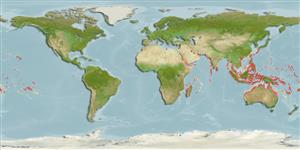Common names from other countries
Environment: milieu / climate zone / depth range / distribution range
Ecologia
marinhas; estuarina associadas(os) a recifes; intervalo de profundidade 0 - 5 m (Ref. 9710), usually 0 - 1 m (Ref. 9710). Tropical; 32°N - 32°S
Indo-Pacific: Red Sea and East Africa to the Line, Marquesan, and Tuamoto islands, north to southern Japan, south to Lord Howe and Rapa.
Tamanho / Peso / Idade
Maturity: Lm ? range ? - ? cm
Max length : 16.0 cm TL macho/indeterminado; (Ref. 48636); 13.2 cm SL (female)
Descrição breve
Chaves de identificação | Morfologia | Morfometria
Espinhos dorsais (total) : 12 - 13; Raios dorsais moles (total) : 19 - 21; Espinhos anais: 2; Raios anais moles: 21 - 23. Males darkly dusky with 5-6 pairs of bands on body and pale stripes on dorsal fin; develop a crest. Females paler in color, bands broken into spots posteriorly, dorsal fin spotted (Ref. 4404).
Facultative air-breathing (Ref. 126274); Intertidal (Ref. 31184, 48636). Adults are common in areas with large rubble pieces which are often used to built breakwaters or to support jetty-pylons (Ref. 48636). They hide in cracks or holes when not feeding. They jump out of the water in energetic skippings to another pool when pursued (Ref. 2158, 48636). May remain out of water under rocks or seaweeds (Ref. 31184). They breathe air when out of water (Ref. 31184). Feeds on filamentous algae (Ref. 89972). Oviparous. Eggs are demersal and adhesive (Ref. 205), and are attached to the substrate via a filamentous, adhesive pad or pedestal (Ref. 94114). Larvae are planktonic, often found in shallow, coastal waters (Ref. 94114).
Life cycle and mating behavior
Maturities | Reprodução | Spawnings | Egg(s) | Fecundities | Larvas
Distinct pairing (Ref. 205).
Springer, V.G. and J.T. Williams, 1994. The Indo-West Pacific blenniid fish genus Istiblennius reappraised: a revision of Istiblennius, Blenniella, and Paralticus, new genus. Smithson. Contrib. Zool. 565:1-193. (Ref. 9962)
Categoria na Lista Vermelha da IUCN (Ref. 130435)
CITES (Ref. 128078)
Not Evaluated
Ameaça para o homem
Harmless
Utilização humana
Pescarias: sem interesse; Aquário: Espécies comerciais
Ferramentas
Relatórios especiais
Descarregue XML
Fontes da internet
Estimates based on models
Preferred temperature (Ref.
115969): 24.7 - 29.3, mean 28.4 (based on 2954 cells).
Phylogenetic diversity index (Ref.
82804): PD
50 = 0.5001 [Uniqueness, from 0.5 = low to 2.0 = high].
Bayesian length-weight: a=0.00741 (0.00335 - 0.01640), b=3.02 (2.83 - 3.21), in cm Total Length, based on LWR estimates for this (Sub)family-body shape (Ref.
93245).
Nível Trófico (Ref.
69278): 2.0 ±0.00 se; based on food items.
Resiliência (Ref.
120179): Elevada, tempo mínimo de duplicação da população menor que 15 meses (Preliminary K or Fecundity.).
Fishing Vulnerability (Ref.
59153): Low vulnerability (10 of 100).
